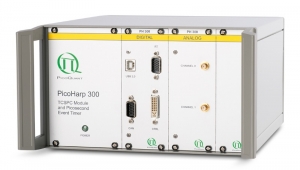Upright Time-resolved Fluorescence Microscope Complete system with laser combining unit, upright microscope body and detection unit Pulsed diode lasers with wavelengths from 375 nm to 810 nm Multiple detector options for up to four detection channels XY-scanning piezo stage for 2D-lifetime imaging Wide range scanner with a scan range up to several cm
The MicroTime 100 is an idea tool for the study of time-resolved photoluminescence of solid samples such as wafers, semiconductors or solar cells. The system is based on a conventional upright microscope body that permits easy access to a wide range of sample shapes and sizes. The MicroTime 100 can be supplied with either manual scanning or with a 2D piezo scanner with either µm or cm resolution.
Flexible excitation subsystem
 The excitation subsystem of the MicroTime 100 consists of a pulsed diode laser driver of the PDL Series and different laser heads with pulses in the picosecond time regime (additional CW mode is available as an option). The available wavelengths range from 375 to 900 nm. Laser power and repetition rate can be flexibly adjusted by the laser drivers of the PDL Series.
The excitation subsystem of the MicroTime 100 consists of a pulsed diode laser driver of the PDL Series and different laser heads with pulses in the picosecond time regime (additional CW mode is available as an option). The available wavelengths range from 375 to 900 nm. Laser power and repetition rate can be flexibly adjusted by the laser drivers of the PDL Series.
The laser heads are either directly coupled to the MicroTime 100 or integrated along with multiple optical components in one Laser Combining Unit (LCU) for easier handling, attenuation and coupling into an optical fiber.
Detection subsystem with single photon sensitivity
 The MicroTime 100 was specially designed for maximum flexibility yet at a very high light collection efficiency. The MicroTime 100 can be configured up to four detection channels which are coupled to the microscope via a multimode fiber. The system can be equipped with a variety of sensitive detectors, which are optimized for wavelength, signal brightness, or photophysical attributes like afterpulsing free detection. The choice of detectors include PMA Series or PMA Hybrid Series detectors and SPADs.
The MicroTime 100 was specially designed for maximum flexibility yet at a very high light collection efficiency. The MicroTime 100 can be configured up to four detection channels which are coupled to the microscope via a multimode fiber. The system can be equipped with a variety of sensitive detectors, which are optimized for wavelength, signal brightness, or photophysical attributes like afterpulsing free detection. The choice of detectors include PMA Series or PMA Hybrid Series detectors and SPADs.
Timing with picosecond resolution
 The data acquisition scheme of the MicroTime 200 is based on the method of Time-Correlated Single Photon Counting (TCSPC) in the unique Time-Tagged Time-Resolved mode (TTTR). Using TTTR data acquisition vastly different measurement procedures ranging from standard lifetime measurements to Fluorescence Lifetime Imaging (FLIM) or TRPL Imaging and even coincidence correlation ("antibunching") can be performed, based on just one fundamental data format. The TTTR format ist supported by all available TCSPC electronics from PicoQuant. Using these high-end integrated devices fluorescence lifetimes down to a few picoseconds or even up to ms for phosphorescence and luminescence studies can be easily resolved.
The data acquisition scheme of the MicroTime 200 is based on the method of Time-Correlated Single Photon Counting (TCSPC) in the unique Time-Tagged Time-Resolved mode (TTTR). Using TTTR data acquisition vastly different measurement procedures ranging from standard lifetime measurements to Fluorescence Lifetime Imaging (FLIM) or TRPL Imaging and even coincidence correlation ("antibunching") can be performed, based on just one fundamental data format. The TTTR format ist supported by all available TCSPC electronics from PicoQuant. Using these high-end integrated devices fluorescence lifetimes down to a few picoseconds or even up to ms for phosphorescence and luminescence studies can be easily resolved.
Intuitive data handling and analysis
 Based on the sophisticated data collection and handling, the system software SymPhoTime 64 supports a multitude of methods, such as intensity time trace, burst analysis, lifetime histogramming, Fluorescence Correlation Spectroscopy (FCS), Fluorescence Lifetime Correlation Spectroscopy (FLCS), Fluorescence Lifetime Imaging (FLIM), TRPL Imaging and Förster Resonance Energy Transfer (FRET), to name only a few.
Based on the sophisticated data collection and handling, the system software SymPhoTime 64 supports a multitude of methods, such as intensity time trace, burst analysis, lifetime histogramming, Fluorescence Correlation Spectroscopy (FCS), Fluorescence Lifetime Correlation Spectroscopy (FLCS), Fluorescence Lifetime Imaging (FLIM), TRPL Imaging and Förster Resonance Energy Transfer (FRET), to name only a few.
SymPhoTime 64 data handling maintains a transparent data structure where all derived data is maintained in one workspace, including a log file to keep track of all measurement and analysis steps.
A large number of algorithms for those methods are already integrated in SymPhoTime 64, providing a analysis platform for ready-to-publish data. At the same time, SymPhoTime 64 offers enhanced flexibility for the integration of novel, cutting edge algorithms by the user. A dedicated scripting language interface allows to modify and expand the analysis routines. In addition to data analysis within SymPhoTime 64, data can be exported to standard formats for external analysis.
Our regularly held SymPhoTime training days offer outstanding support for new and advanced users.
Scientific guidance and user training
 PicoQuant annually holds the European short course on "Time-resolved Microscopy and Correlation Spectroscopy". The course is intended for individuals wishing an in-depth introduction to the principles of time-resolved fluorescence microscopy and its applications to the Life Sciences. This 3-day event consists of lectures as well as instrumentation and software hands-on training. For details see the course website.
PicoQuant annually holds the European short course on "Time-resolved Microscopy and Correlation Spectroscopy". The course is intended for individuals wishing an in-depth introduction to the principles of time-resolved fluorescence microscopy and its applications to the Life Sciences. This 3-day event consists of lectures as well as instrumentation and software hands-on training. For details see the course website.



 Download PDF
Download PDF Inquery Form
Inquery Form